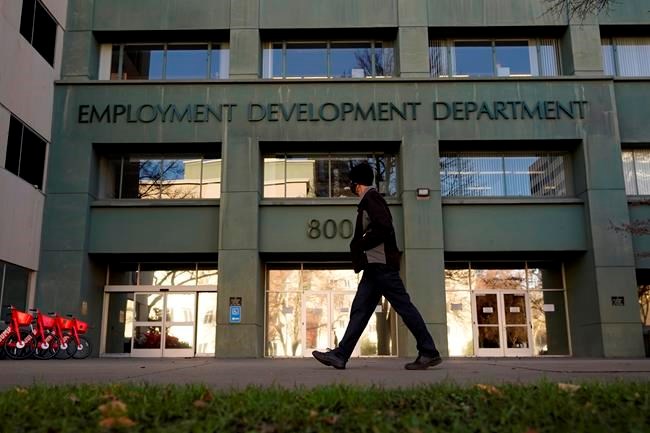WASHINGTON (AP) — Fueled by vaccinations and government aid, the U.S. economy grew at a solid 6.5% annual rate last quarter in another sign that the nation has achieved a sustained recovery from the pandemic recession. The total size of the economy has now surpassed its pre-pandemic level.
Thursday’s report from the Commerce Department estimated that the nation’s gross domestic product — its total output of goods and services — accelerated in the April-June quarter from an already robust 6.3% annual growth rate in the first quarter of the year.
The latest figure fell well below the 8%-plus annual growth rate that many economists had predicted for the second quarter. But the miss was due mainly to clogged supply chains related to the rapid reopening of the economy. Those bottlenecks exerted a larger-than-expected drag on companies' efforts to restock their shelves. The resulting slowdown in inventory rebuilding, in fact, subtracted 1.1 percentage points from last quarter's annual growth.
By contrast, consumer spending — the main fuel of the U.S. economy — surged for a second straight quarter, advancing at an 11.8% annual rate. Spending on goods grew at an 11.6% rate, and spending on services, from restaurant meals to airline tickets, expanded at a 12% pace as vaccinations encouraged more Americans to shop, travel and eat out.
Companies, too, spent with confidence last quarter. Business investment surged at an 8% annual rate in the April-June quarter, adding 1.1 percentage point to GDP.
With consumers and businesses expected to keep spending, many analysts expect the economy to grow at a robust pace of around 6.5% for all of 2021, despite the supply shortages and the possibility of a resurgent coronavirus in the form of the highly contagious delta variant. That would amount to the strongest calendar-year growth since 1984.
Growth that strong would far exceed the 2% to 3% average annual rates of recent decades. And it would represent a striking bounce-back from the economy's 3.4% contraction last year in the midst of the pandemic, the worst decline since the 1940s.
Underpinning the rapid recovery have been trillions in federal rescue money, ranging from stimulus checks to expanded unemployment benefits to small business aid to just-distributed child tax credit payments. And millions of affluent households have benefited from a vast increase in their wealth resulting from surging home equity and stock market gains.
"Consumers are going to continue to drive the economic train," said Mark Zandi, chief economist at Moody's Analytics. “There is a lot of excess savings, a lot of cash in people's checking accounts.”
Jen Psaki, the White House press secretary, hailed the GDP report and called on Congress to go further by passing the administration's proposals to vastly expand the nation's infrastructure.
Overhanging the bright economic forecasts is the threat posed by the delta variant. The U.S. is now averaging more than 60,000 confirmed new cases a day, up from only about 12,000 a month ago. Should a surge in viral infections cause many consumers to hunker down again and pull back on spending, it would weaken the recovery.
For now, the economy is showing sustained strength. Last month, America’s employers added 850,000 jobs, well above the average of the previous three months. And average hourly pay rose a solid 3.6% compared with a year earlier, faster than the pre-pandemic annual pace.
Consumer confidence has reached its highest level since the pandemic struck in March 2020, a key reason why retail sales remain solid as Americans shift their spending back to services — from restaurant meals and airline trips to entertainment events and shopping sprees.
The economy is also receiving substantial support from the Federal Reserve. On Wednesday, the Fed reaffirmed that it will maintain its key short-term interest rate at a record low near zero to keep short-term borrowing costs low. It will also continue to buy government-backed bonds to put downward pressure on long-term loan rates to encourage borrowing and spending.
The recovery, in fact, has been so rapid, with pent-up demand from consumers driving growth after a year of lockdowns, that one looming risk is a potential spike in inflation that could get out of control. Consumer prices jumped 5.4% in June from a year ago, the sharpest spike in 13 years and the fourth straight month of sizable price jumps.
The measure of consumer inflation in the second-quarter GDP report showed an annual rise of 3.4% for core inflation, which excludes food and energy. It was the fastest such jump since 1991.
In addition to the drag on GDP from weak inventory restocking, reflecting the supply chain problems, housing construction fell at a 9.8% annual rate last quarter. This decline reflected, in part, the troubles home builders have had in obtaining lumber and other supplies.
Some economists have warned that by choosing not to begin withdrawing its extraordinary support for the economy, the Fed may end up responding too late and too aggressively to high inflation by quickly jacking up rates and perhaps causing another recession.
But at a news conference Wednesday, Fed Chair Jerome Powell underscored his belief that recent inflation readings reflect price spikes in a narrow range of categories — from used cars and airline tickets to hotel rooms and auto rentals — that have been distorted by temporary supply shortages related to the economy’s swift reopening. Those shortages involve items like furniture, appliances, clothing and computer chips, among others.
Martin Crutsinger, The Associated Press


